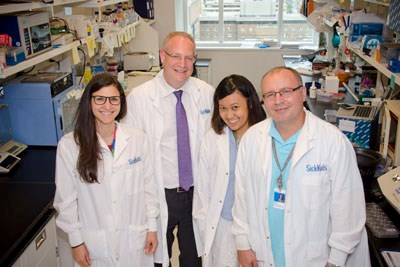Muscle function regained in CRISPR-treated mice with congenital muscular dystrophy, SickKids study finds
Summary:
Scientists at The Hospital for Sick Children (SickKids) have used the gene-editing tool CRISPR to correct a disease-causing mutation in mice with a form of congenital muscular dystrophy, MDC1A.
TORONTO – Scientists at The Hospital for Sick Children (SickKids) have used the gene-editing tool CRISPR to correct a disease-causing mutation in mice with a form of congenital muscular dystrophy, MDC1A. The findings, published in the July 17 online edition of Nature Medicine, show significant improvement in muscle strength and function among the mice treated with CRISPR, with no remaining signs of paralysis.
MDC1A is a rare neuromuscular disease affecting one in 150,000 worldwide. It is caused by a mutation in a gene called laminin alpha 2 and is characterized at birth by muscle weakness and low muscle tone, as well as brain abnormalities. Babies born with this condition eventually lose all muscle function and live an average of 30 years.

“We’ve identified a novel technique that is safe, efficient and effective in mice. This is a huge leap forward and the step we needed if we want to get serious about using CRISPR as a therapeutic option for patients,” says Dr. Ronald Cohn, principal investigator of the study, Paediatrician-in-Chief and Senior Scientist at SickKids.
In this study, CRISPR has been used to target mutations in the DNA referred to as “splice site mutations”. This type of mutation results in alterations to genes that affect the body’s ability to make specific proteins. The team is currently looking to test this technique in the cells of patients with MDC1A caused by a splice site mutation.
A 2015 study published in the American Journal of Human Genetics described how Cohn’s team used CRISPR in the lab to successfully remove a duplicated gene in cells of a patient with Duchenne muscular dystrophy. The team is currently working on recreating the patient’s specific mutation in an animal model to see if that technique will work in mice. This new Nature Medicine paper approached it from the other side, using a mouse model with naturally occurring muscular dystrophy. “We took an existing mouse model for a different type of muscular dystrophy, MDC1A, and developed a way to correct the splice site mutation that causes the disease in the mouse,” says Cohn, who is also Chair of Paediatrics and Professor at the University of Toronto.
CRISPR technology has already been shown to cut genes very efficiently; however, inserting the corrected piece of genetic information is more difficult. The insertion of corrected genetic information requires help from a specific pathway in the cell. The problem is this pathway isn’t efficient in skeletal muscle and neurons, which are most affected in congenital muscular dystrophy.
“Our approach is unique in the way we use an alternative process to correct the mutation. Instead of inserting the corrected piece of information, we used CRISPR to cut DNA in two strategic places. This tricked the two ends of the gene to come back together and create a normal splice site,” says Dr. Dwi Kemaladewi, first author of the study and Research Fellow in Genetics & Genome Biology at SickKids.
The team hypothesized that this approach would work well in skeletal muscles; however, the overall improvements in terms of mobility and motor function were marginal. It turned out that they also needed to also target the peripheral nerves, in addition to skeletal muscles, to significantly improve the disease characteristics.
“This is important because the development of therapeutic strategies for muscular dystrophies have largely focused on improving the muscle conditions. Experts know the peripheral nerves are important, but the skeletal muscles have been perceived as the main culprit in MDC1A and have traditionally been the focus of treatment options,” adds Kemaladewi.
Cohn explains that while this study focused on splice site mutations in MDC1A, there are hundreds of disorders that are caused by splice site mutations so the findings offer proof-of-concept that the technique they used could be amenable to many conditions.
The project investigators collaborated with the Industry Partnerships and Commercialization Office at SickKids. This research was supported by AFM-Telethon postdoctoral fellowship, Cure CMD, SickKids Foundation and through Cohn’s RS McLaughlin Foundation Chair in Paediatrics. It is an example of how SickKids is contributing to making Ontario Healthier, Wealthier and Smarter www.healthierwealthiersmarter.ca.
About The Hospital for Sick Children
The Hospital for Sick Children (SickKids) is recognized as one of the world’s foremost paediatric health-care institutions and is Canada’s leading centre dedicated to advancing children’s health through the integration of patient care, research and education. Founded in 1875 and affiliated with the University of Toronto, SickKids is one of Canada’s most research-intensive hospitals and has generated discoveries that have helped children globally. Its mission is to provide the best in complex and specialized child and family-centred care; pioneer scientific and clinical advancements; share expertise; foster an academic environment that nurtures health-care professionals; and champion an accessible, comprehensive and sustainable child health system. SickKids is proud of its vision for Healthier Children. A Better World. For more information, please visit www.sickkids.ca. Follow us on Twitter (@SickKidsNews) and Instagram (@SickKidsToronto).
Media contacts:
Caitlin Johannesson
The Hospital for Sick Children
416-813-7654, ext. 201436
caitlin.johannesson@sickkids.ca
Matet Nebres
The Hospital for Sick Children
416-813-6380
matet.nebres@sickkids.ca

